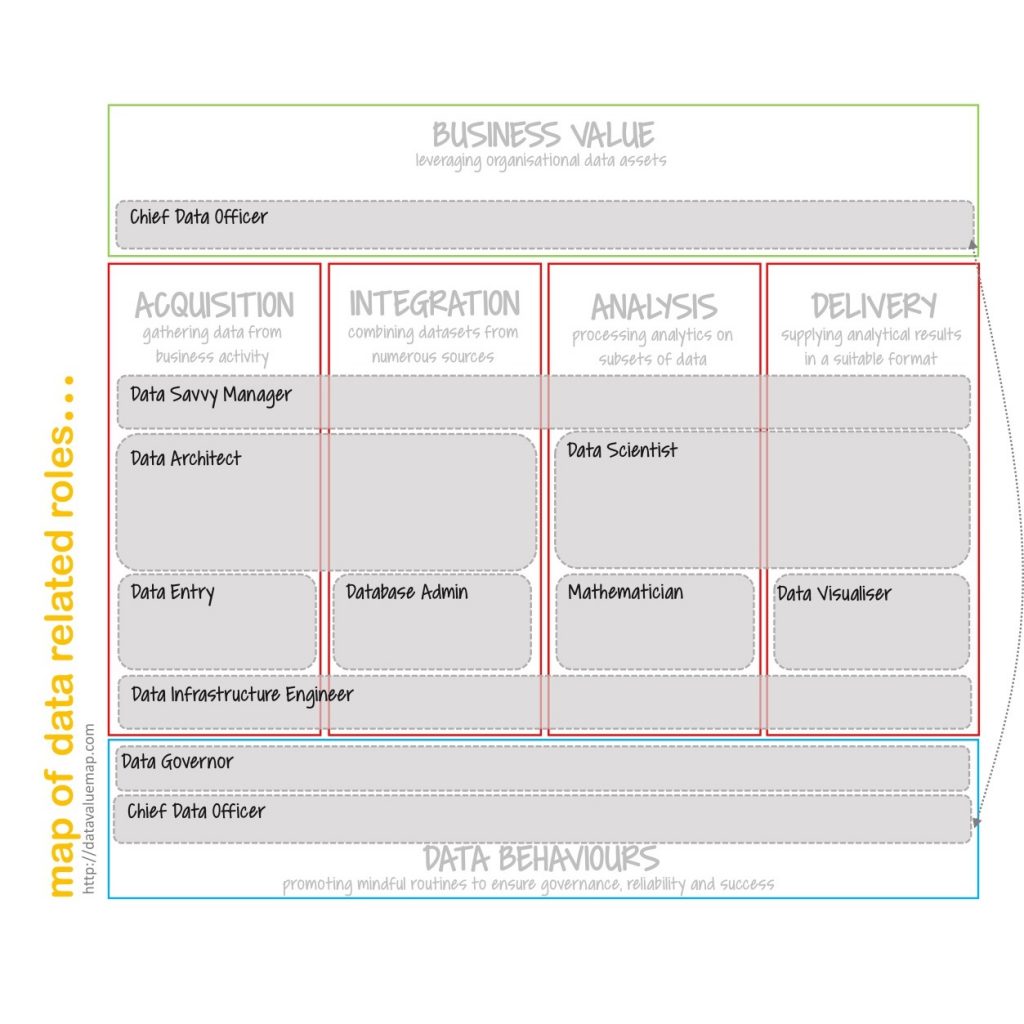With data top of the agenda for pretty much every organisation, there has been flurry of new data job titles. Some of these titles relate to new roles, while others are a rebranding of existing ones. With the aim of bringing some clarity to the subject I have visualised all data related roles based on core competencies using the Data Value Map (http://datavaluemap.com). In a sense, all data related roles should touch on all aspects of the Data Value Map, indeed, a visual could be mapped for each one individually. However, for simplicity the visualisation has focused on the core competencies of each role. So, if you are planning a data related career or looking to do a data course that will align with that career, the map should help you navigate the jargon and focus on what’s important. If nothing else, it will give you an insight into what all the data people in your organisation actually do.

Chief Data Officer (CDO) – this is a new role and reflects the strategic importance organisations are placing on data. The CDO is responsible for all data activities and sits above managers of specialist data departments (e.g. Head of Data Analytics). To do this a CDO needs a significant understanding of all data aspects to ultimately develop and leverage it as a strategic asset. A CDO must be expert in building a data vision or strategic business cases as well as understanding how to lead the organisation in successfully executing this vision through the promotion of appropriate data behaviours.
Data Architect – a senior data position in the landscape of data roles, a data architect’s primary objective is to ensure effective integration of an organisations data to support operational and strategic goals. Focusing on data integration and by extension data acquisition from organisational information systems, key capabilities would involve data modelling and an understanding of the data structures within those systems.
Data Scientist – this is the current title to what was previously labelled as a data miner, data analyst, data analyst or business intelligence analyst. While, different types of data and the introduction of different technologies has played a part in defining the various titles (just put ‘big’ in front of your title), the role is essentially the same across all of them. This primarily includes applying analytics on datasets to deliver historic, predictive or prescriptive insights into business operations. However, this is based on the assumption of access to good quality integrated data. If this is not the case, the role will involve a significant amount of data cleaning.
Database Administrator – one the of the most common data roles in organisations, it involves the management of database software and the tuning of databases for performance. This involves the modelling of data but in a form that aligns with the technology upon which it is implemented. Other tasks include, making sure the database software is up-to-date and that all security/backup/access functions are correctly applied.
Data entry – these are very often entry roles or positions that handle the input and collection of data. This can be in the form of manual entry and require a certain amount of aggregation through spreadsheets. In addition, these roles are often the stepping-stone to higher-level roles in the business or data domain.
Data Infrastructure Engineer – this role is more positioned in the technology domain, to which there is a whole other ecosystem to be mapped. However, technology does play a significant (and complicated) part in supporting an organisations data capability. A data infrastructure engineer looks after the technical infrastructure that supports the four stages (acquisition to delivery) and keeps up-to-date with the latest technological innovations.
Data Governor – one of the least known roles, a data governor promotes the development of routines that ensure data reliability and compliance with regulation. The role is coming more into focus as organisations grapple with new regulations such as GDPR and PSD2.
Mathematician – more specialised than a data scientist, a mathematician (or statistician) focuses on the development of analytical models and mathematical algorithms. Drawing heavily on statistical theories the models/algorithms are utilised in a wide range of areas that span from the pricing of insurance premiums to the powering of artificial intelligence applications.
Data Savvy Manager – while all types of managers recognise the importance of data, they still struggle with leveraging it. A data savvy manager has a good understanding of how data impacts on their business and are able to define and guide data initiatives across all four stages (acquisition to delivery) to improve business performance.
Data Visualiser – this role involves presenting the data in a form that will best fulfil the needs of the user (e.g. explaining or exploring). Another title for such a role is data storyteller and includes the ability to effectively communicate the key messages in analysed datasets.
By Tadhg Nagle